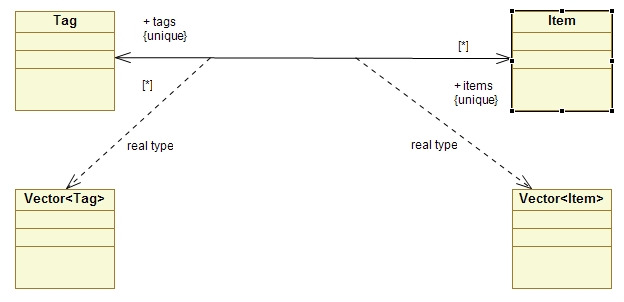Notice: This Wiki is now read only and edits are no longer possible. Please see: https://gitlab.eclipse.org/eclipsefdn/helpdesk/-/wikis/Wiki-shutdown-plan for the plan.
MoDisco/ModelFilter
The goal of the ModelFilter plug-in is to extract specific information from java projects, and to show it as UML models.
- First application is to initialize a graph of dependencies from one selected element, with the level of recursion provided as a parameter.
- Second application is to show method calls as a pseudo sequence diagram using dependencies between methods, numbered from 1 to n to indicate the order.
- Third application is to represent the real type of properties when an interface has been used in java code.
Contents
Description
To discover an application, you may use SimpleTransformationsChain to obtain a UML model which represents the whole application structure. Or you may use the ModelFilter plug-in to focus on different aspects. It could be represented by little models dedicated to one element, or a complete model but with added information. Depending on the complexity of the application and resulting UML model, you will have to select a different kind of model.
The dependencies graph is clearly well fitted to show how several little models could be useful. Representation of method calls as a pseudo sequence could be done by little models or by one complete model; it has been implemented as one model to show how different diagrams have to be used to mask complexity of model elements. And representation of real type for properties show how a complete model could be improved with a few details.
Dependencies graph
From a selected class in a java application, you choose the recursion level of the search for dependencies and you will get a UML model which represents a dependencies graph from the selected class. Structural links, like association, inheritance, etc. are of course available, but we have added UML dependencies to show local uses of a type, or method parameters. It is very useful to detect usage of qualified types or usage of a type in the same package.
Method calls
To represent method calls as pseudo sequence, we use UML dependencies from one method (caller) to other methods (callee). Each dependency is named with the name of the called method suffixed by a number which represents its order in the sequence of method calls.
Real type of properties
When the type of a property is an interface, it is interesting to represent its real type as a dependency in a UML model:
User manual
To illustrate the ModelFilter plugin and its features, we will use a sample inspired from the Pet Store Application.
Get and install use case
The models are available from the MoDisco SVN in subdirectory "examples/trunk/org.eclipse.gmt.modisco.usecase.modelfilter.sample" or from a downloadable archive. If you use a SVN client in Eclipse (Subversive or Subclipse), the project will be immediately available in your Eclipse workspace.
Sources of the Pet Store application are available here: http://www.oracle.com/technetwork/java/petstore1-3-1-02-139690.html
You may have to download several libraries to obtain an eclipse project without errors (JPA, JTA, JSF-apis and Servlets-jsp-apis). A complete bundle is also available from Mia-Software... To view this application in your Eclipse workspace, you will have to extract the content of this archive, and use the "import" wizard (import project in workspace).
Dependencies graph
To get the dependencies graph of a particular class, you have to right-click on the class in the Package Explorer, and select Discovery > Actions > Display Dependencies
Then, a graph displaying the dependencies will open:
Method calls
Right-click on a project and select Discovery > Actions > Display Method Calls. A graph displaying all the method calls will open:
You will have a better look if we focus on a particular method. For example, the methodpublic List<SelectItem> getCategories()
public List<SelectItem> getCategories() { // return categories for a JSF radio button ArrayList<SelectItem> arCats=new ArrayList<SelectItem>(); // get the CatalogFacade for the app FacesContext context=FacesContext.getCurrentInstance(); Map<String,Object> contextMap=context.getExternalContext().getApplicationMap(); CatalogFacade cf=(CatalogFacade)contextMap.get("CatalogFacade"); // get the categories from the database List<Category> catsx=cf.getCategories(); for(Category catx : catsx) { // add categories to be displayed in a radio button arCats.add(new SelectItem(catx.getCategoryID(), catx.getName())); } return arCats; }
Right-click on the method in the Package Explorer, and select Discovery > Actions > Display Method Calls:
Real type of properties
To get the UML model with real type of properties, right-click on the java project you would like to inspect, and select Discovery > Discoverers > Create UML model with real types information on associations:
Then, you will have a complete UML model with the real types of Associations:
You will have a better look if we focus on a particular association. For example, the properties
private Collection<Item> items
in class Tag and
private Collection<Tag> tags
in class Item both located in package com.sun.javaee.blueprints.petstore.model.
Current limitations
Dependencies graph
- The dependencies gaph does not reflect some implicit dependencies, for example with nested method calls:
String entryPagesParam = filterConfig.getServletContext().getInitParameter("entryPages");
Method calls
- Diagrams have to be built manually with Papyrus
- Method calls should be represented with a uml sequence diagram
Real type of properties
- Diagrams have to be built manually with Papyrus
- Initializations through parameters or local variable are not managed
- Initializations through method calls are not managed
Team
Gabriel Barbier (Mia-Software)
Install
You can install the discoverer from the MoDisco update site.
As part of the "Use cases layer" which is not embedded in MoDisco SDK, you cannot install it from eclipse or modeling update site. Please use MoDisco release update site.
| MoDisco | |
| Components | Infrastructure: KDM · SMM · GASTM · Model Browser · Discovery Manager · MoDisco Workflow · Query Manager · Facet Manager · Metrics Visualization Builder · KDM Source Extension Technologies: Java · JEE · EjbJar · WebApp · XML Use Cases: Simple Transformation Chain · Model Filter |
| Help | Installation · SVN |
| Project | API Policy · Retention Policy · Project Plan · metrics · Accessibility Guidelines · Capabilities Disablement |








